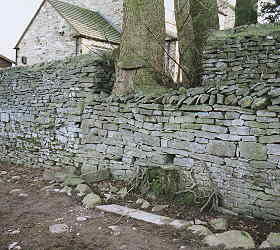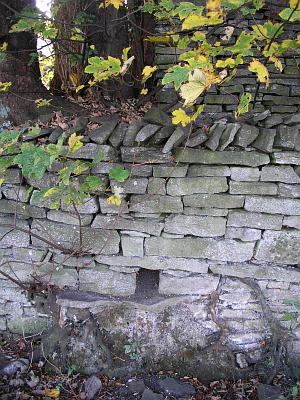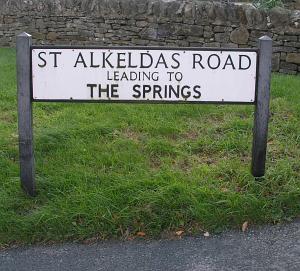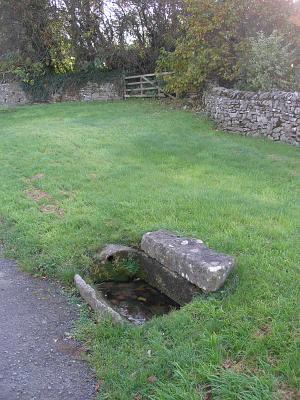|
St
Alkelda's Well (site of) - Middleham
(SE 1239 8795)
On a visit to this well back in 1988 we
walked through the churchyard and across open fields to reach the site. A small wooden sign on the
tree by the well read 'St Alkelda's Well', but this was the only
real indication of the significance of this spot. Originally the water
from a spring behind the wall flowed through a gap in the walling and into a
trough below, but apparently the water stopped flowing after a school was built in the fields
to the south of the well.
In 1999 the situation was, if anything, rather more disappointing. The wooden sign
was still there, but a new housing estate had replaced the open fields,
with houses built right alongside the well.
The opportunity to restore a water supply to the
well when the houses were being built had been missed and so 'St
Alkelda's well' still remains a neglected aspect of Middleham's heritage.
Ironically
the road to the estate is called 'St Alkeldas Road' (see pic
below).
The great shame is that this is the only holy well in Britain dedicated to
this Saint, plus there are only two church dedications to St
Alkelda, one here at Middleham, with the other at Giggleswick. So Alkelda
was a very local saint.
A build up of 'petrified' moss and vegetation
can still be
seen below the opening where the water used to flow out and this indicates that the
spring water had a high mineral content. Such wells and spa's were often
regarded as having healing properties, and this is confirmed for St
Alkelda's Well by R.C. Hope (1) who noted that........
'There is a spring here, the waters of which are considered very
beneficial for weak eyes.'
W.G. Barker's (2) account of Middleham church also adds......
'A spring which rises not far off, is named St Alkelda's well. The
water of this fountain was accounted beneficial for weak eyes and the
writer knew a Protestant lady, who died not long since at an advanced age,
who in early youth was accustomed to repair to it every morning and who received
much relief from its strengthening qualities.'
The connection with the nearby St
Alkelda's church also
makes it likely that the water from the well was used in church services
and baptisms etc.
William Grainge (3), writing in the mid
1800's, described the well water as rising in the fields behind the
church and piped to a trough by the road. This field road is the modern footpath that passes the well today and
the few stones remaining on the site suggest a trough once stood by
the wall to catch the water (perhaps the broken trough pictured below?).
Grainge also suggested that the saints name may be derived from a local
holy woman or hermit
who was linked with a sacred spring in the area, eventually becoming known
as St, Al-kelda, - 'the saint of the holy well'.
It seems possible that in the future more houses will be built in the
field in front of the well, so is there a chance that the well site will be
preserved and restored? Perhaps as a local heritage feature in the new
development, and then Middleham will once again haves its St Alkelda's
Well.
.
(1) Holy Wells of England, Robert Charles Hope 1893 (p199)
(2) Three Days of Wensleydale, W.G. Barker 1854 (p18)
(3)Nidderdale, William Grainge,1863
|

(1999)

(2006)

|



